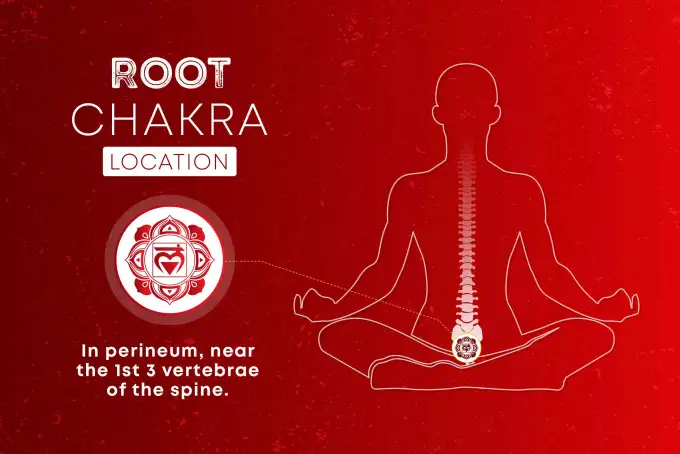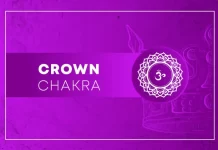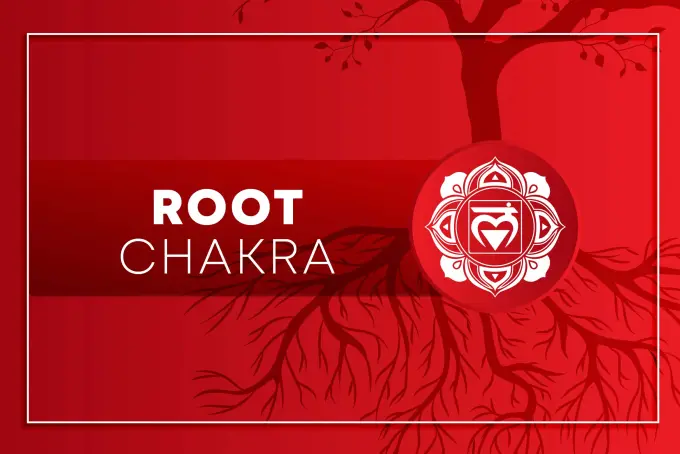The Root Chakra at a Glance
| Sanskrit Name | Muladhara |
| Location | The base of the spine is the pelvic floor. |
| Color | Red |
| Seed Mantra | Lam |
| Element | Earth |
| Qualities | Stability, survival instinct, and security |
| Signs of balance | Full of vitality, fearlessness, and a sense of belonging |
| Signs of imbalance | Fatigue, constipation, fear, anxiety, lack, and instability |
What is Root Chakra?
The first of seven chakras located at the base of the spine in our subtle body is the root chakra. Being the primary and base chakra, its energy serves as the building block for all the chakras above.
The root chakra is referred to as Muladhara in Sanskrit. The words Mula and Adhara, which together imply “support” or “base,” are the roots of the term “Muladhara.” Muladhara is its name because it develops from the moment of conception and offers a solid foundation for the development of the spine and other body organs.
Your root chakra is out of balance if you experience a sense of insecurity regarding fundamental necessities like food and shelter or if you only have faith in yourself.
A center of instinctive energy, the root chakra. It implies that everything we require for survival and evolution on this planet, including our basic wants and emotional needs, a sense of safety and security (the fight-flight or freeze reaction), and so forth, originates from the root chakra. When these primal wants are satisfied, the root chakra is balanced, and you feel secure and grounded.
Where exactly is root chakra located?

The root chakra lies precisely at the tailbone, where three vertebrae join to form a triangular-shaped region, in the pelvic floor. Your root chakra is located in the middle of this condensed space in your subtle body.
By placing your hands at the tailbone with your fingers pointed downward, you may physically feel the placement of the root chakra. Your root chakra is located where your little finger contacts the pelvic floor while pointing downward.
The anus and vaginal core are where the root chakra is found in females. It is located behind the genital organ or cervix. In contrast, this chakra is located above or inside the perineum in males.
What is the color of the Root chakra?
Red is the color of energy that comes forth from the root chakra. It’s because this chakra is most closely associated with the earth element, and the red color reflects the inner surface and core of the earth.
Red is the hue of energy and resolve that stimulates the limbic system of the brain, which is why the root chakra is red. The limbic system controls the actions necessary for our survival. eating, reproduction, and the reaction to flight or fight
Additionally, the color red also symbolizes how closely we are related to the earth. How well you are aware of yourself determines how connected you are to the environment. Your basic requirements would become more apparent to you as you became more self-aware, and this is what a balanced root chakra does.
Also Read: 7 Chakra Colors and & Science Behind Them
What does the Root chakra symbol show?

Four straightforward elements make up the root chakra symbol: a downward-pointing triangle, a square, lotus petals, and text lam in the middle.
- Downward-pointing triangle – It points towards the earth and home of Kundalini Shakti in this chakra. Also, the downward arrow reminds us to be grounded and connected to the earth.
- A square inscribed in a circle – The square shown in the root chakra symbol is the representation of a firm foundation to support everything. Earth being the element of root chakra provides us with that firm foundation.
- Lotus flower 4 petals – 4 lotus petals represent the connection between Nadis and chakras. It indicates the merging of 4 nerves (Nadis) at the root chakra. These 4 Nadis in the symbol represented with 4 Sanskrit syllables वं (vaṃ), शं (śaṃ), षं (ṣaṃ), and सं (saṃ).
- Text लं on the center – “Lam” is the ‘Bija Mantra’ (seed mantra) of the root chakra. Its sound has the power to stimulate the earth element and so the Root Chakra.
- In certain literary references, the root chakra sign is displayed with a picture of an elephant inside the square. The elephant represents Mother Earth carrying the burden and, as a result, represents the inner power connected to this chakra.
Key characteristics of the root chakra
The Root Chakra governs the following functions in our body;
- The root chakra, located in the middle of our bodies, regulates the blood flow to the left chamber of the heart as well as the operation of our skeleton bones, kidneys, intestines, adrenal glands, and bladder.
- The location of the root chakra corresponds to the location of the dormant kundalini energy. Awakened Kundalini or an open root chakra is referred to as the entrance to higher energy in spiritual terminology.
- The Muladhara chakra is controlled by our animal instincts and is primarily influenced by our senses of taste and smell for survival.
Also Read: Chakra Symbols and Their Meaning & Significance
How to know if the root chakra is balanced?

A person’s root chakra emanates energy in all areas of their life when it is spinning at a balanced rate. Activities that explore your physical and emotional side are more prevalent in your life. As a result, you spread positive energy in all spheres of life.
The signs of a balanced root chakra are;
- Full of vitality and passion – In a balanced root chakra state, you are more passionate about whatever you do. You would experience vitality and a feeling of responsibility for your work, family, and friends.
- Satisfaction with survival needs – You tend to be more satisfied while striving to meet the needs of surviving.
- Connected with core values – Balanced root chakra is all about governing the force of being grounded. Hence, a person with a balanced root chakra would be connected with the core values of life.
- Equanimity of logic and emotion – When your root chakra is balanced, it helps you to keep your mind equally drawn to the logic and emotion in something you are more active.
- Fearless personality – A person with Root Chakra aligned feels fearless and prepared for physical, financial, moral, and psychological tasks.
How to know if the root chakra is imbalanced?

When the root chakra is out of balance, a person has a sense of unfinishedness and withdrawal from everything.
Root chakra imbalance can manifest as either under-activity or overactivity.
1. When Root Chakra is Under-active
In case of an under-active root chakra imbalance,
- When depression overtakes you, you stop doing whatever you had planned or intended to do.
- You are more likely to have hazy emotions of insecurity and begin living a solitary life.
- It gets tougher to trust people the more you’re lacking in energy. You become more egocentric as a result. This makes you live a life apart from the environment and your surroundings.
2. When Root Chakra is Overactive
- You become overconfident when your root chakra is overactive, which leads to the emergence of the following symptoms.
- An overabundance of root chakra energy may cause you to lose sight of the fundamental idea that you are a creature of the soil.
- You start to grow possessive and have a tendency to become overly attached to people or things, which makes you stiffer both physically and mentally.
- Some characteristics of having an overactive root chakra include being impatient, angry, aggressive, and greedy.
What causes the root chakra imbalance?
The root chakra may become unbalanced as a result of a recent accident or a recurring phobia. An underactive root chakra may result from a trauma that has been hurting you for a long time (Childhood Trauma).
Moreover, some general causes of root chakra imbalance are;
- A toxic relationship
- Longtime illness
- Abuse at an early age
- Mounting fear
- Abandonment in relationships
- Have been in relative poverty or
- Lack of empathy for your family.
Problems caused by the imbalanced root chakra
The imbalance of the root chakra shows up as a variety of physical and psychological issues. The following issues could arise if your root chakra is out of harmony.
1. Physical Problems
Physically, the pelvic region, where the root chakra is located, represents the main issues with the bladder, kidney, lower spine, adrenal glands, prostate, hip flexors, and leg joints.
Female irregular menstruation, blood disorders, constipation, diarrhea, piles, hemorrhoids, colitis, prostate cancer, glaucoma, renal ailments, and foot pain are a few physical issues brought on by an unbalanced root chakra.
2. Psychological Problems
When the root chakra is out of balance psychologically, you become more dependent on and indulge in any outside source of satisfaction.
A root chakra imbalance can also lead to other mental health issues, such as irritability, eating disorders, depression, high blood pressure, money addiction, headaches, and obstinate conduct.
How to balance root chakra?

Your root chakra, which serves as a link between your body and the outside world, is highly susceptible to imbalance. There are many external agencies that can have an impact, but it can also be balanced with a few little actions.
If you are having issues with your root chakra, you might try the following exercises.
1. Do Meditation with Mantras and Mudras
When you lack physical and psychological grounding, one of the frequent reasons for the disturbed root chakra.
In addition to opening up your inner world, meditation also strengthens your grounding.
Although there are various meditation techniques available to balance your root energy, the simplest one to adopt is a focused seated asana with mantra chanting and mudras.
Use this quick meditation technique to balance your root chakra in a quiet area.
- Sit in padmasana (lotus pose). Make Gyan mudra or Earth mudra with your hands.
- Imagine a link forming between the pelvic floor and the soil as you bring your focus to the actual location of the root chakra.
- Chant the seed mantra “Lam” aloud or subvocally to strengthen the connection. Mantra chanting produces vibrations that boost root energy, making it simpler to maintain balance.
- You can also practice seated asana meditation on the tip of the nose to balance root energy because the nose is the sensory organ of the root chakra.
2. Ground yourself with yoga poses
Another straightforward method you may use to regulate your root energy is physical activity.
Asanas, which are physical postures used in yoga, strike a better balance between ease and exertion.
Pavanamuktasana (wind-relieving stance), Padmasana (lotus pose), Malasana (garland pose), Tadasana (mountain pose), and Virabhadrasana 2 are a few yoga poses that concentrate on energy linked to the root chakra (warrior pose 2).
To feel more grounded, you can practice yoga positions on the lush grass. By enhancing hip mobility, strengthening the lower legs and thighs, and relieving back discomfort, it balances the energy of the root chakra.
3. Harness the energy of stones
Some crystals and stones have a vibrational frequency that can balance your Root Chakra again. The lowest vibrational frequency, 396Hz, is felt at the root chakra.
Red-colored stones have a resonance with the root chakra because the Muladhara Chakra is associated with the color red. These are red carnelian, red jasper, and bloodstone. Each stone has a unique set of qualities, and as a result, so does its symbolic meaning for the Root Chakra.
- Red carnelian, which stands for courage and strength and is utilized to clear and activate the Root Chakra, can be worn.
- Red jasper for the root chakra is well known for purifying and balancing the wheel. You can wear it if your root chakra is weak or overactive.
- If your self-esteem has decreased and you’re trying to get rid of your negative energy, the bloodstone for the root chakra is right for you.
Also Read: 10 Powerful Root Chakra Crystals for Healing
4. Nourish yourself with green veggies
Since there is less direct or indirect touch with the earth, the Root Chakra is lacking. It’s time to sample some heavenly treats so you can balance your first wheel.
To begin a new chapter of repair in your diet, include more green and root vegetables. Beets, onions, garlic, tomatoes, potatoes, carrots, radishes, and beetroot are a few of the vegetables.
5. Color Therapy
Color therapy is one of the most popular and well-known ways to balance a chakra when you sense that it is out of harmony. Immersing yourself in the hue related to that chakra is color therapy. This entails saturating yourself in all things red for the root chakra. Take red food. Put on red clothing.
Turn on the red candles. (If they have an earthy fragrance, even better.) If at all feasible, fill your local space with as many red objects as you can. Even better, keep some painting supplies on hand for when the mood strikes. Bring out your inner artist and create a picture that is entirely crimson.
6. Walk Barefoot in the Dirt
Since the soil represents the root chakra, this is the ideal time to spend time outside and allow your bare feet to touch the ground. Of course, depending on where you reside, this can be more challenging for some. Try to locate a location where you can spend some time in nature if at all possible. Since our nature is essentially our foundation, this enables us to return to our roots.
7. Journaling
In these times, affirmation writing is very effective. Remind yourself that you are secure, safe, and exactly where you should be. Any of the aforementioned journaling questions may also be used. I also enjoy writing as my highest self by visualizing myself as my most genuine and elevated self.
You can imagine yourself living your safest, most grounded existence while you write about the root chakra in particular. Describe the sensations of safety you have in your body and in the present.
8. Meditation
Visualize a red light at the base of your spine that is glowing for an unguided root chakra meditation. As you breathe in and out, watch the light grow stronger. A crimson lotus flower at the base of your spine is another image you might use.
9. Affirmations
Affirmation repetition, whether silently or aloud, is a potent technique if you’re unable to sit down and write as I indicated in the section on journaling. This can be done at any moment, including when getting ready for the day, taking a shower, or traveling to work. This might be combined with other suggestions on the list, like going for a walk in the woods.
What is the root chakra responsible for?
What blocks the root chakra?
The root chakra becomes blocked when our thoughts and feelings either conflict with or withdraw from our physical reality, and we don’t realign ourselves. Symptoms of a root chakra blockage can include various mental signs such as anxiety disorders, lethargy, and eating disorders.
What happens when you open your root chakra?
When the Muladhara Chakra is awakened and energy is flowing freely, it brings positivity to all aspects of our lives. A healthy and balanced Root Chakra creates a strong connection to our earthly instincts. It improves overall confidence and increases the sense of self-worth.
Conclusion
It is simple to identify when or how your Root Chakra becomes misaligned. Each state embodies its unique symptoms and root reasons. To remain grounded and vibrant, all you can do is direct your attention inward. Only meditation, the right mudras, the wearing of the right stones, and the consumption of foods that are naturally red can bring about this state.





















